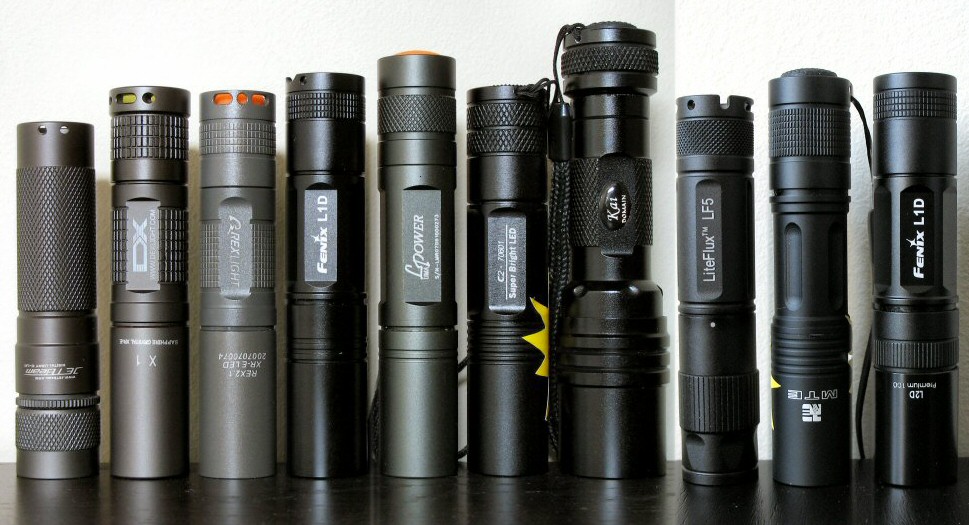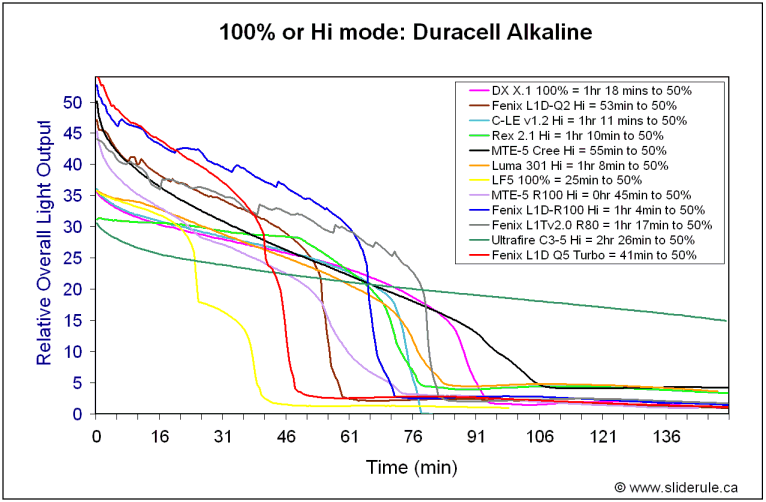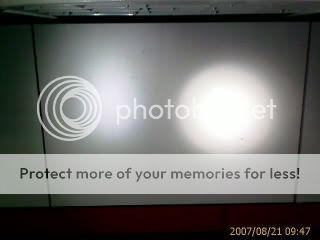Rebel, Cree, SSC Multi-Stage 1AA Review: RUNTIMES and BEAMSHOTS!
REVIEWER'S NOTE: This thread has been replaced with a new comparison review of the latest multi-stage 1AA lights:
Multi-stage 1AA Review - Part III: Runtimes, beamshots & more!
This thread is an older Part II update of my original Multi-stage AA review. For single-stage 1AA, please see my Single-Stage 1AA review thread.
Update Oct 7/07:Just posted a review of the new Jetbeam C-LE v2.0 clicky version. I haven't bothered to update the graphs in this review, since output and runtime are virtually exactly the same as the previous v1.2 shown here, although v2.0 runtime did increase marginally on the low modes.
Update Oct 22/07: Just added Fenix L1Tv2.0 R080 runtimes. See my detailed comparison of the Fenix lights here: Fenix Rebel vs Cree: L1D/L1T/P2D OUTPUT, RUNTIMES, BEAMSHOTS
Update Oct 31/07: Added new multi-stage Ultrafire C3 (labelled as C3-5 on graphs, for 5-mode). See my detailed comparison review to old single-stage model here: Ultrafire C3 Multi-stage vs Single-stage: RUNTIMES, BEAMSHOTS, detailed pics!
Update Nov 27/07: Added Fenix L1D with Premium Cree Q5 head results, including 14500 runs for the first time. See my Fenix L2D Q5 vs R100, R80, Q2, P4 Comparison Review: RUNTIMES+ for more comparison of the premium Cree Q5 and Rebel R100 heads on L2D body.
The contenders:
From left to right: Jetbeam C-LE v1.2, DealExtreme X.1, Rexlight 2.1, Fenix L1DCE-Q2, Lumapower 301, MTE 5-Stage Cree, Kai 5-Stage Cree, Liteflux LF5 SSC, MTE 5-Stage Rebel R100, Fenix L1D Revel R100 Premium (L2D head). (Fenix L1Tv2.0 and Ultrafire C3 not shown)

Beamshots:
On Hi/100% with Duracell Alkaline.




Method: All my output numbers are relative for my home-made light box setup, a la Quickbeam's FR.com method. My relative overall output numbers are typically similar to his, although generally a little lower. You can directly compare all my review graphs - i.e. an output value of "10" in one graph is the same as "10" in another.
Throw values are the square-root of lux measurements taken at 1m using a light meter.
Summary Chart for 2650mAh NiMH on Hi/100%


Notes:
DX X.1, JB C-LE, Ultrafire C3: All use PWM for lower modes, freq for the X.1 is 120 Hz, the C-LE v1.2/v2.0 is 317 Hz, and multi-mode C3 is 297Hz. The newer C-LEs also have improved threads over previous versions, is a bit thicker in diameter, and features a "memory mode" that retains last setting used. No memory mode on multi-stage C3. V2.0 comes with a good quality reverse clicky.
Rex 2.1: Now has a 2sec memory mode that works on all batteries, and three 3 sets of light sequence states that you can access ("Daily/Tactic/Advanced"). For a full comparison to the Rex 2.0, see my review here.
L1D & L1T: Same current-controlled goodness as earlier L1DCE, shown here with the Special Edition Q2 Cree emitter (with textured reflector) and "Premium" Rebel R100 head from the new L2D Rebel. Also added new premium Q5 Cree head and L1Tv2.0 with Rebel R080 head.
Lumapower 301: Updated version of this light with SSC emitter. Uses a tailcap resistor for low mode.
DX/Kai 5-stage lights: a number of these are offered with different emitters and body styles (3 are shown above), but all the Cree lights at least have the same circuit with same runtime/output characteristics. MTE R100 version has a different body style from previous models.
Liteflux LF5: Uses high freq PWM for lower modes - can't measure the freq with my setup, but it is obviously quite high as it produces no noticeable flicker in my testing. Standard mode is 15% and 50% output, and I've set user-defined to either highest (100%) or lowest (<1%) for testing purposes.
Runtimes:
"Hi" mode on NiMH (Duracell 2650mAh), except for Luma 301 (Sanyo 2500mAh)

Hi/Med/Lo modes on Alkaline Duracells



Hi and Medium-Low modes on an AW Protected 14500 (750mAh)


Key observations:
JetBeam C-LE
DealExtreme X.1:
Rexlight 2.1 vs. 2.0:
Fenix L1D Cree lights (Q5, Q2 and older P4 model) vs Rebel L1D/L1T versions
Lumapower 301 SSC
DX/Kai 5-stage Cree/Rebel lights, now including Ultrafire C3 multi-mode
Liteflux LF5 SSC
Conclusion:
:sweat:Whew - there you have it! Hopefully that is helpful for you :kiss:.
REVIEWER'S NOTE: This thread has been replaced with a new comparison review of the latest multi-stage 1AA lights:
Multi-stage 1AA Review - Part III: Runtimes, beamshots & more!
This thread is an older Part II update of my original Multi-stage AA review. For single-stage 1AA, please see my Single-Stage 1AA review thread.
Update Oct 7/07:Just posted a review of the new Jetbeam C-LE v2.0 clicky version. I haven't bothered to update the graphs in this review, since output and runtime are virtually exactly the same as the previous v1.2 shown here, although v2.0 runtime did increase marginally on the low modes.
Update Oct 22/07: Just added Fenix L1Tv2.0 R080 runtimes. See my detailed comparison of the Fenix lights here: Fenix Rebel vs Cree: L1D/L1T/P2D OUTPUT, RUNTIMES, BEAMSHOTS
Update Oct 31/07: Added new multi-stage Ultrafire C3 (labelled as C3-5 on graphs, for 5-mode). See my detailed comparison review to old single-stage model here: Ultrafire C3 Multi-stage vs Single-stage: RUNTIMES, BEAMSHOTS, detailed pics!
Update Nov 27/07: Added Fenix L1D with Premium Cree Q5 head results, including 14500 runs for the first time. See my Fenix L2D Q5 vs R100, R80, Q2, P4 Comparison Review: RUNTIMES+ for more comparison of the premium Cree Q5 and Rebel R100 heads on L2D body.
The contenders:
From left to right: Jetbeam C-LE v1.2, DealExtreme X.1, Rexlight 2.1, Fenix L1DCE-Q2, Lumapower 301, MTE 5-Stage Cree, Kai 5-Stage Cree, Liteflux LF5 SSC, MTE 5-Stage Rebel R100, Fenix L1D Revel R100 Premium (L2D head). (Fenix L1Tv2.0 and Ultrafire C3 not shown)

Beamshots:
On Hi/100% with Duracell Alkaline.




Method: All my output numbers are relative for my home-made light box setup, a la Quickbeam's FR.com method. My relative overall output numbers are typically similar to his, although generally a little lower. You can directly compare all my review graphs - i.e. an output value of "10" in one graph is the same as "10" in another.
Throw values are the square-root of lux measurements taken at 1m using a light meter.
Summary Chart for 2650mAh NiMH on Hi/100%


Notes:
DX X.1, JB C-LE, Ultrafire C3: All use PWM for lower modes, freq for the X.1 is 120 Hz, the C-LE v1.2/v2.0 is 317 Hz, and multi-mode C3 is 297Hz. The newer C-LEs also have improved threads over previous versions, is a bit thicker in diameter, and features a "memory mode" that retains last setting used. No memory mode on multi-stage C3. V2.0 comes with a good quality reverse clicky.
Rex 2.1: Now has a 2sec memory mode that works on all batteries, and three 3 sets of light sequence states that you can access ("Daily/Tactic/Advanced"). For a full comparison to the Rex 2.0, see my review here.
L1D & L1T: Same current-controlled goodness as earlier L1DCE, shown here with the Special Edition Q2 Cree emitter (with textured reflector) and "Premium" Rebel R100 head from the new L2D Rebel. Also added new premium Q5 Cree head and L1Tv2.0 with Rebel R080 head.
Lumapower 301: Updated version of this light with SSC emitter. Uses a tailcap resistor for low mode.
DX/Kai 5-stage lights: a number of these are offered with different emitters and body styles (3 are shown above), but all the Cree lights at least have the same circuit with same runtime/output characteristics. MTE R100 version has a different body style from previous models.
Liteflux LF5: Uses high freq PWM for lower modes - can't measure the freq with my setup, but it is obviously quite high as it produces no noticeable flicker in my testing. Standard mode is 15% and 50% output, and I've set user-defined to either highest (100%) or lowest (<1%) for testing purposes.
Runtimes:
"Hi" mode on NiMH (Duracell 2650mAh), except for Luma 301 (Sanyo 2500mAh)

Hi/Med/Lo modes on Alkaline Duracells



Hi and Medium-Low modes on an AW Protected 14500 (750mAh)


Key observations:
JetBeam C-LE
- Although the runtimes shown above are from v1.2, the new v2.0 output/runtime characteristics are exactly the same. Main improvement is a good quality reverse clicky, which makes it easier to reliably switch modes. See my v2.0 review here.
On Hi, the C-LE v1.2/v2.0 have slightly increased output compared to earlier versions, with similar runtimes, but now with a more rapid drop-off to zero output. - On Medium, C-LE v1.2/v2.0 has greatly improved output and runtime
- On Low, C-LE v1.2/v2.0 has about the same runtime as the older versions, but with twice the output.
- v1.2/v2.0 C-LE now includes 2sec "memory mode" feature that retains the last setting used
- Mode switching and memory feature can have intermittent problems (i.e out of seqeuence errors, missing modes, etc) on v1.2 if you don't keep the contacts/screw threads very clean. No evidence of problems on the new v2.0 so far, thanks to the new reverse clicky.
DealExtreme X.1:
- Pretty much identical to the older JB MkIIX, its output and runtimes are definitely on the low side compared to some of the newer lights.
- Very bright and regulated output on 14500, but runtime nowhere near the new Rex 2.1
- Good build quality and very versatile, but complex UI may be off-putting for some
Rexlight 2.1 vs. 2.0:
- If this new Rex 2.1 uses PWM, I can't measure it on my sample. The old Rex 2.0 ran at a noticeable 94 Hz.
- All light modes now work as they are supposed to, on all battery types, with excellent runtimes in all modes now.
- Outstanding performance on 14500. Light also features a 3.2-3.0V "low voltage" warning (i.e. light strobes), so you can safely use unprotected cells
- Light also features 3 sets of usage modes ("Daily/Tactic/Advanced"), with access to different output modes in each - but switching between them can be a bit confusing
- Well worth the upgrade - only downgrades from 2.0 are in beam tint and "ringiness" on my sample, plus some UI issues
Fenix L1D Cree lights (Q5, Q2 and older P4 model) vs Rebel L1D/L1T versions
- The Rebel versions of the L1D/L1T come with a R080 (or maybe R090) emitter. Also tested here is the L2D head, which has the "premium" R100 emitter.
- The Cree version shown here is the Special Edition with the Q2 emitter and textured (orange peel) reflector, also tested is the new Q5 head from the L2D premium.
- See my original Fenix Rebel vs Cree: OUTPUT, RUNTIMES, BEAMSHOTS thread for direct comparison of R100, Q2, and P4 version results
- See my Fenix L2D Q5 vs R100, R80, Q2, P4 Comparison Review: RUNTIMES+for an analysis of the premium Cree Q5 and Rebel R100 heads on L2D form.
- The Cree Q5 is slightly brighter than the Rebel R100 version, but with less runtime. Rebel R100 version is slightly brighter than the Q2 Cree, depending on battery type and mode, and with better throw.
- The Rebel R080 version is not as bright a R100, but still quite respectable. Output on Low on the L1Tv2.0 is bit higher than the L1D light, contributing to the shorter runtime.
- Color rendition outdoors seems better on the Rebel lights compared to the Cree lights
- L1Tv2.0 comes with the much sought-after forward clicky, which seems of very high quality.
- Beam profiles on the R100 and R080 heads seem closer to the SSC lights than the Cree lights, but with better throw than the Cree lights reviewed here.
- L1D remains the output/runtime king - nothing else beats Fenix's current-controlled low modes, regardless of which head you go for.
- Runtimes on 14500 have now been added for L1D with Q5 head. You loose low modes initially as light runs in direct drive from max output until it hits the low mode level, and then switches into regulation (briefly - you have little time left at regulated lower levels, since battery is typcally almost exhausted by then). Turbo mode (i.e. head tightened) is difficult to do, due to extra length of the protected 14500 (I had to use a copper ring spacer for it to make contact and screw down tight).
Lumapower 301 SSC
- New version has a SSC U-bin emitter, providing a less sharply defined hotspot than the other Cree lights reviewed here
- Light uses a resistor for Low mode, so is not as efficient at other choices, but still quite good runtime for the output with long "moon mode."
- Can take 14500, but Manufacturer does not recommend it on Low mode - circuit not designed for it, produces reduced output and runtime compared to Hi mode
- Build quality quite good - very substantial feel and nice anodizing, but longer than other lights here and can't tail-stand
- Battery tube not wide enough to take all high capacity NiMH (i.e. none of my 2650mAh would fit, so Hi runtime is based on a 2500mAh battery)
DX/Kai 5-stage Cree/Rebel lights, now including Ultrafire C3 multi-mode
- Except for the C3, all the other DX/Kai Cree/Rebel lights seem to use a similar circuit, and so have similar output/runtime characteristics but in different body formats with different beam profiles. That circuit lacks a truly low mode: seem to be 100%/70%/40% for Hi/Med/Low.
- The new multi-mode C3 has much lower output levels, and very reasonable modes (I'd estimate 100%/40%/10%). Although absolute output is typically lower than other 1AA lights, runtimes on alkaline are very impressive on all modes.
- New multi-mode C3 can also run on 2AA, which is now approximately twice as bright as 1AA modes.
- Unlike other Rebel lights, the MTE R100 is not as bright or long lasting as the Cree versions. The MTE R100 has relatively warm tint on Hi, but turns very pink/purplish on the Medium/Low modes. :green: Beam profile is also full of artifacts
- The MTE R070 light (results not shown) is only about 2/3 as bright as the R100 reported here, with roughly equivalent runtimes.
- In keeping with budget price, build quality is quite variable on all these lights. Ultrafire C3 seems to be among the best of the lot, although the multi-stage version has lower build quality than single stage (see my discussion here).
- All lights have excellent relative performance on alkaline on Hi (with a very long low "moon mode"), but the new multi-stage C3 stands out as the runtime champ on lower modes.
Liteflux LF5 SSC
- Good build quality and nice smooth, relatively floody beam thanks to the SSC emitter, but overall spillbeam width is narrower than the other lights reviewed here.
- Very good output and runtime on NiMH and 14500, somewhat similar to the Rex 2.1, although LF5 is one of the best regulated lights I've seen
- Runtime on alkaline is rather disappointing on all levels - consistently lower than the other lights tested here.
- Light features lowest low mode of all lights tested here. In user-defined mode you can get the light down to ~0.3 on my output scale (i.e. 1/6 as bright as the Rex 2.1 low). This is slightly brighter than my SSC-modded 1st gen VB-16 on level 2. Continuous runtime is an impressive 15 days at this level, on alkaline.
- Twisty interface is a bit unusual and takes some practice at first, but does allow you to skip the strobe/SOS modes if you want.
- Light comes as a nice kit with loads of goodies - please see my detailed LF5 review for more info.
Conclusion:
- On regular batteries, L1D body with the Q5 head is definitely your best choice for max output or throw, although the R100 head is probably your best choice for output/runtime. On Hi, the new L1T with R080 (or potentially R090 emitter) is typically intermittent to Cree P4/Q2 versions in overall output, but with slightly better runtimes on my samples.
- If you like a low Lo mode with long runtime, the Rex 2.1 or LF5 are your best picks. The LF5 can go as low as ~0.3 on my output scale (with two weeks worth of continuous runtime at this level, on alkaline).
- On 14500 batteries, Rex 2.1 or LF5 are your best choices for output/runtime, although the DX X.1 still remains the brightest with regulated output - but with much lower runtimes compared to the Rex 2.1 or LF5. On Fenix L1D on 14500, you "loose" the lower levels initially, as light runs direct drive from max output until the low level is reached and regulation kicks in (typically near the end of the battery life).
- C-LE v2.0 and Lumapower 301 are both excellent choices in the mid-range (~$30), but lacking in some of the features/extras of the higher-end lights.
- Budget DX/Kai models have variable quality and uncertain emitters. The new Utrafire multi-mode C3 is the real winner of this crowd, although overall output is toward the lower end of the 1AA spectrum. Ability to run 2AA with increased output is a real bonus.
UPDATE 11/27/07: I can no longer recommend the Ultrafire C3, since the latest shipping versions from DX have been all over the map in terms of output and build quality. There's even one recent report of one arriving with the old 5-stage circuit installed!
:sweat:Whew - there you have it! Hopefully that is helpful for you :kiss:.
Last edited:




